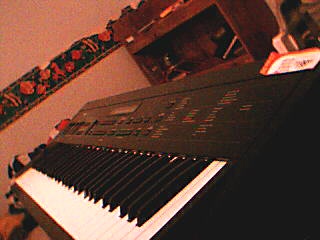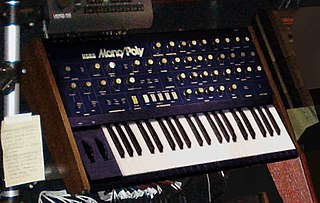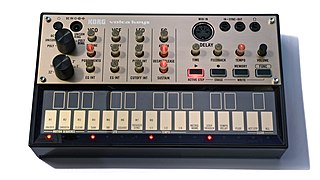
The Realistic Concertmate MG-1 is an analog synthesizer manufactured by Moog Music in 1981 and sold by Radio Shack from 1982 to 1983 under their "Realistic" brand name. It was produced without some standard Moog features, such as pitch and modulation wheels, as a cost-cutting measure aimed at achieving a lower price for the consumer market. The synthesizer also featured a pair of pass-through RCA jacks, which allowed users to mix radio or records into the final live synthesized sound output.

The microKORG is a MIDI-capable digital synthesizer/vocoder from Korg featuring DSP-based analog modelling. The synthesizer is built in such a way that it is essentially a Korg MS-2000 with a programmable step arpeggiator, a less advanced vocoder, lack of motion sequencing, lack of an XLR microphone input, and in a smaller case with fewer real-time control knobs.

The Korg DW-8000 is a polyphonic hybrid digital-analog synthesizer released in 1985. It blends digital waveforms with an analog filter and amplifier, followed by a digital delay for adding echo effects. It boasts eight-note polyphony and its keyboard is equipped with velocity sensitivity and aftertouch.
Polyphony is a property of musical instruments that means that they can play multiple independent melody lines simultaneously. Instruments featuring polyphony are said to be polyphonic. Instruments that are not capable of polyphony are monophonic or paraphonic.
The Korg Poly-61(PS-61) is an analog programmable polyphonic synthesizer released by Korg in 1982, as a successor to the Polysix. It was the first affordable synthesizer to feature two oscillators per voice, and was Korg's first largely "knobless" synthesizer, replacing the traditional knobs and switches found on the Polysix with a series of parameter selectors and two incrementing buttons that allowed the user to program sounds one section at a time.

The Korg Wavestation is a vector synthesis synthesizer first produced in the early 1990s and later re-released as a software synthesizer in 2004. Its primary innovation was Wave Sequencing, a method of multi-timbral sound generation in which different PCM waveform data are played successively, resulting in continuously evolving sounds. The Wavestation's "Advanced Vector Synthesis" sound architecture resembled early vector synths such as the Sequential Circuits Prophet VS.

The Elka Synthex is a polyphonic analog synthesizer produced by Italian music instrument manufacturer Elka from 1981 to 1985.
The Siel DK70 is a synthesizer produced in 1986 by Siel.

Roland JX-8P is a 61-key, velocity- and aftertouch-sensitive, six-note polyphonic, almost entirely analog synthesizer released by Roland in 1985. In a time of rising popularity of digital frequency modulation synthesizers, such as Yamaha DX7, JX-8P was marketed as the best of both worlds: while it was possible to create classic analog synth sounds, several new modulation parameters and redesigned hardware enabled it to produce certain types of sounds associated with FM synthesis, such as metallic percussive sounds. Likewise, traditional hands-on controls were replaced with a Yamaha DX7-style interface with membrane buttons and one "edit" slider.
The Korg DSS-1 is a 12-bit polyphonic sampling synthesizer released in September 1986. It came out at a time when many of the popular synthesizer companies were beginning to get into sampling, an area of sound design that had previously been left to a handful of fledgling companies such as Fairlight, E-mu, and Ensoniq. Like Yamaha and Casio, however, Korg did not stay long in the sampling arena. The DSS-1 was the company's only sampler until 1998 when Korg introduced sampling options on their Triton and Trinity series of workstations, and on their Electribe series of drum-and-phrase samplers.
Casio's SDSynthesizers were a late-1980s line of analog synthesizers featuring a resonant filter. SD synthesis was traditional DCO-analog synthesis, with the main difference being that some of the SD waveforms' harmonic spectrums changed temporally, or dynamically in relation to the amplitude envelope.

The Prophet '08 is a polyphonic analog synthesizer released by Dave Smith Instruments (DSI) in 2007. As with DSI's other instruments, the Prophet '08 uses analog subtractive synthesis. Similar in functionality to the renowned Sequential Circuits Prophet-5 popularized in the 1970s, the Prophet '08 has an all analog signal path; however its envelopes are generated digitally.

The Korg DS-8 is a digital eight-voice FM synthesizer released by Korg in 1987. Following an agreement with Yamaha for access to its research and development facilities, it was designed using Yamaha components and constructed under a licensing agreement. It introduced an analog-style interface for controlling FM sounds and could play different patches on each of its eight voices, marking it as Korg's first multi-timbral MIDI synthesizer. Accompanying its launch was the Korg 707, a more portable version of the DS-8, lacking digital effects but equipped with strap pegs for keytar performance.

The Korg Mono/Poly (MP-4) is a paraphonic analog synthesizer released by Korg in 1981, bridging the gap between monophonic and polyphonic synthesis. Released in the same year as the Korg Polysix, as a complementary synth, The Mono/Poly is equipped with four VCOs and can operate as a four-voice paraphonic synth with limited capabilities, or as a monophonic synth using all four oscillators. Upon its release, it was the only monophonic synthesizer with an integrated quad-VCO design available on the market.

The Korg DW-6000 is a polyphonic hybrid digital-analog synthesizer released in 1985. It blends digital waveforms with an analog filter and amplifier, also incorporating a chorus effect to create an enriched analog sound. The DW-6000 features six-note polyphony and was quickly succeeded by the DW-8000, also released in 1985, which introduced a velocity sensitive keyboard with aftertouch, a built-in arpeggiator, increased polyphony and waveforms, and substituted the chorus effect with a digital delay effect.
Paraphony is a term which has three distinct meanings in the field of music.

The Korg Minilogue is a polyphonic analog synthesizer released in 2016 by Korg. It offers users four-voice polyphony with two analog VCOs per-voice and was designed to be affordable. It was designed by Korg engineer and synthesizer designer Tatsuya Takahashi, who said "the concept of the Minilogue was to build an analog synthesizer that doesn't rely on the fame and success of an old synth".

The Korg Trident is a polyphonic multi-section synthesizer released by Korg in 1980, combining three distinct synthesizers within a single instrument:: a polyphonic section with two VCOs, alongside dedicated String and Brass sections.. The polyphonic synthesizer section allows for eight-note polyphony with dual oscillators. The String section offers an ensemble effect and simple attack/release envelope controls, whereas the Brass section features an independent filter and a dedicated ADSR envelope. These sections can be assigned to two different regions of the keyboard independently, and the Trident also offers a flanger effect along with a joystick for pitch bending and modulation.

The Volca Keys is a analogue synthesizer manufactured by the Japanese music technology company Korg. It was announced in April 2013 at MusikMesse and was at the time one of the few affordable analogue synthesizers available. The Volca Keys uses subtractive synthesis to create sounds and is three-note paraphonic, meaning that it can play chords with all voices sharing a single voltage-controlled filter (VCF).













